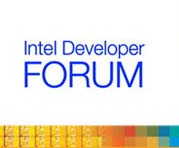 HEXUS attended a pre-IDF warm up speech from Steve Pawlowski who leads the Digital Enterprise group, from which you’ll see high end chipset and server products.
HEXUS attended a pre-IDF warm up speech from Steve Pawlowski who leads the Digital Enterprise group, from which you’ll see high end chipset and server products.
Pawlowski explained the perception of multi-core processors in both software and hardware terms. From a software standpoint, the Operating System has access to more than one processor, so in a single chip dual core system running two threads, each thread can have its own processor. From a hardware standpoint Intel believes a multi-core solution is a package which contains 2 or more execution cores.
However, there is more than one way to produce a package with 2 or more execution cores on it and you can have different core layouts to suit different markets and products. Take Montecito for example, which is 2 cores on the same processor – this is expensive due to development costs and time to market. Compare that to Presler on 65nm, where there are 2 separate pieces of silicon within the core. This is essentially putting 2 socketed units in the same package.
Intel are giving a push towards multi-core due to the volume of data which is now available on the internet and within networks, seeing how important it is to be able to compute all the information at hand rapidly.
Intel believes the demands of the user are what will define the future of multi-core solutions. They expect more intelligent, easier to use platforms will be required, something which can be facilitated by the power of multi-core processing. Furthermore, they see the power of multi-core as a means of more accurately modeling and simulating data, perhaps taking away some of the guesswork.
So how much performance? Teraflop levels of performance, they say.
Despite the move to multi-core processors, the integration of transistors within a die will increase at the same rate of Moore’s law.
So, the following is what’s likely to unfold:
2012 – 22nm – 32 billion transistors
2014 – 16nm – 64 billion transistors
2016 – 11nm – 128 billion transistors
2018 – 8nm – 256 billion transistors
One day you will see the performance per transistor will level out.
Intel also want to portray an image of them as a company providing solutions to businesses, rather than simply a company that sells chips. As an example, we’ve seen their ‘Centrino’ product prove to be a successful solution for the mobile businessman.
So what about battery life and multi-core? Single core always seems to be a trade off between performance and battery life. Intel claims multi-core designs can deliver the right combination of performance and battery life.
Regardless of whatever hardware is running under the hood, software is essential to the proper deployment of any solution. So, will Intel be pushing for programmers to embrace parallelism?
As the processors increase in performance, so must the subsystems that work with them. I/O and memory bandwidth needs to increase, as does the memory interconnect bandwidth.
When will x86 come to an end? Intel say they will be making x86 processors for a long time, so the architecture is likely to remain at the heart of the PC for a while yet.
Looking to the future, Intel reckon that by 2010 you will have a system which in the region of 1 to 2 teraflops of performance. However, this is dependant on I/O and Memory bandwidth being able to keep up.














